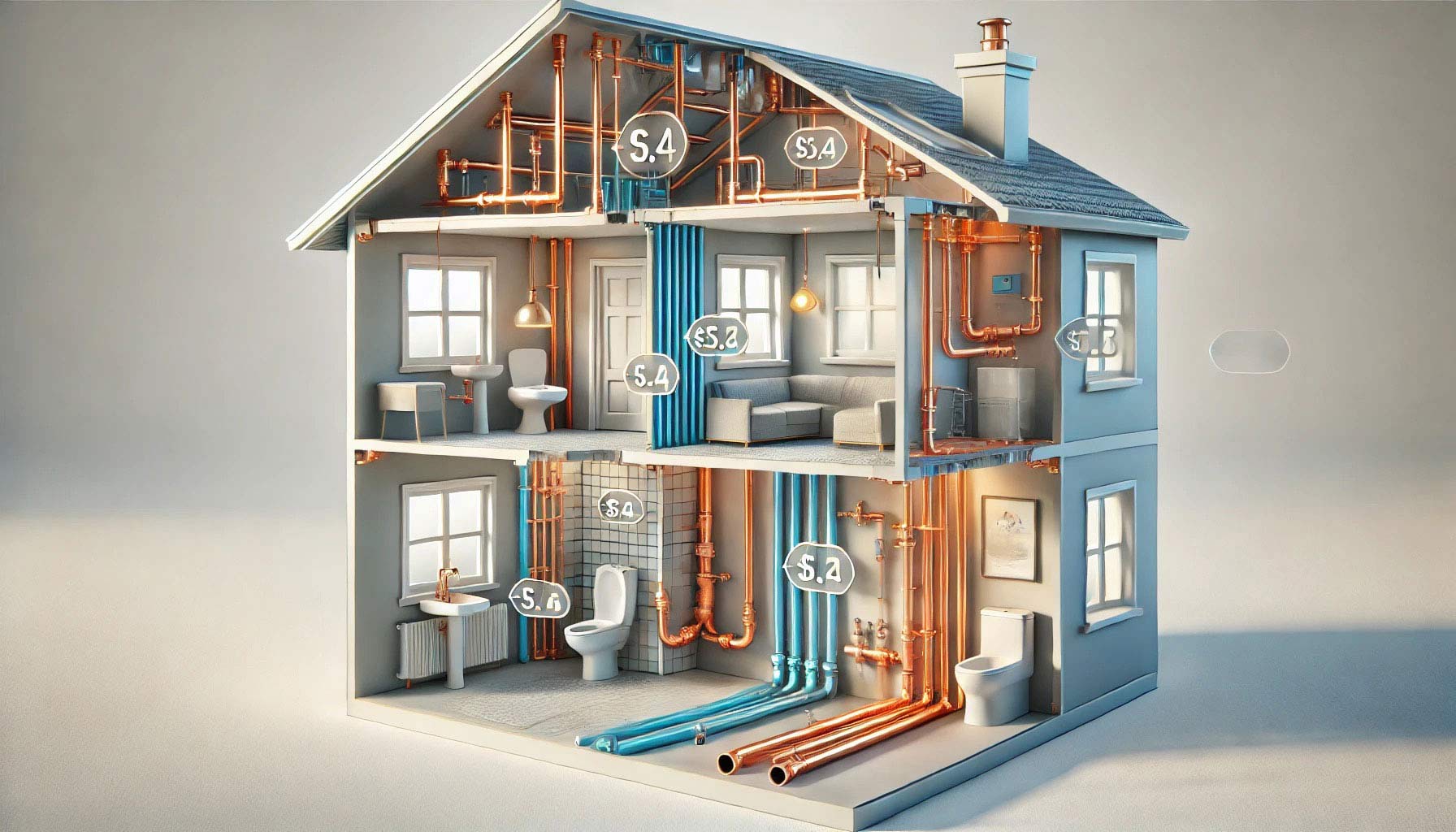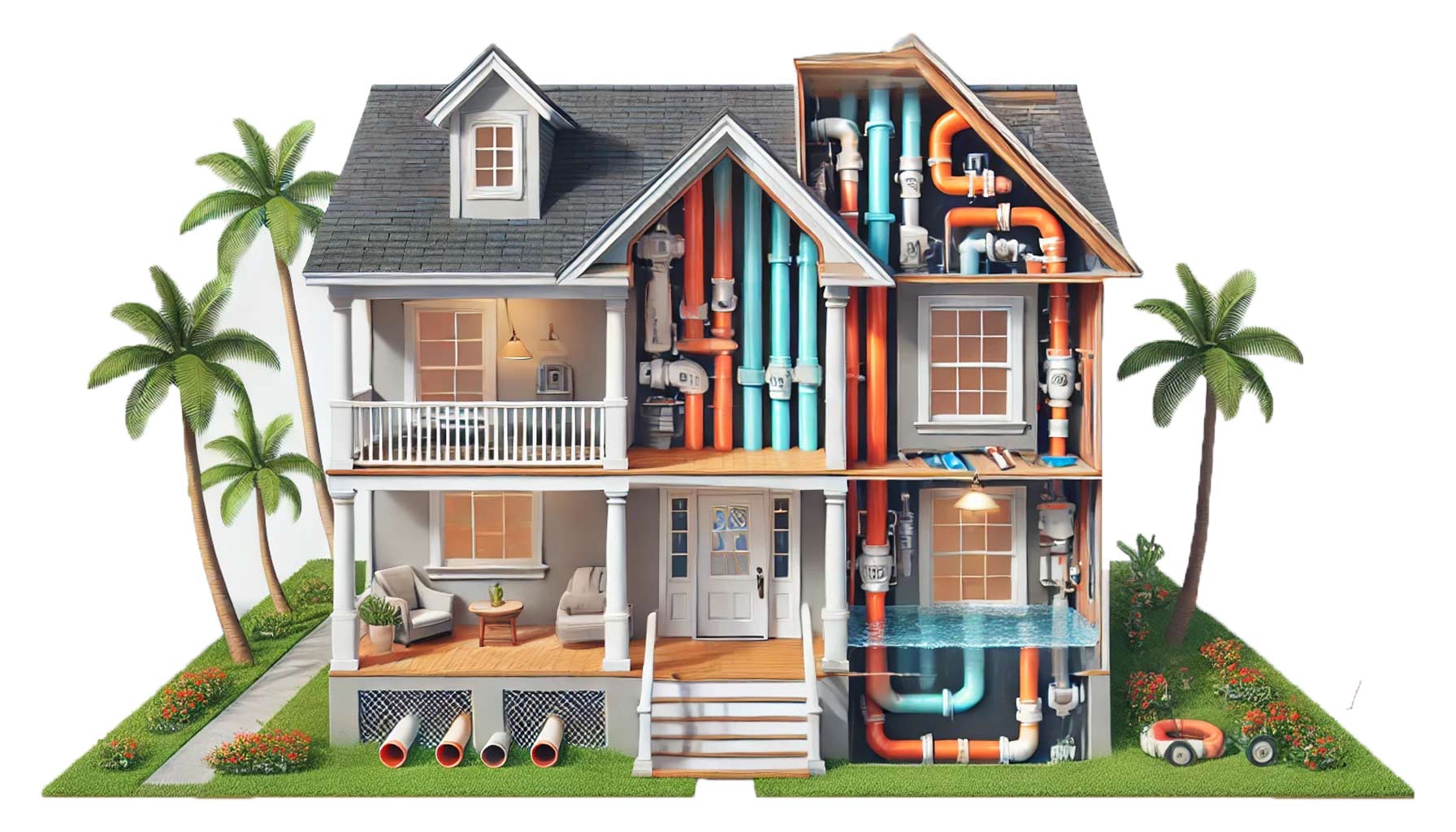If your home’s plumbing system is outdated, leaky, or made from problematic materials like polybutylene or galvanized steel, repiping your entire house might be the best solution. While the process of a whole-house repipe can feel overwhelming, it’s a long-term investment that ensures a reliable plumbing system and prevents costly water damage. One of the first questions homeowners have is: how much does it cost to repipe a house?
The answer depends on several factors, including the size of your home, the materials you choose, and the complexity of the job. In this blog, we’ll break down the costs associated with a whole-house repipe and help you understand what to expect.
Average Cost to Repipe a House With PEX
The cost of a whole house repipe typically ranges from $5,000 to $15,000, with most homeowners spending around $5,000 to $8,000. However, your final cost will depend on factors such as:
- Home Size: Larger homes require more piping, increasing both material and labor costs.
- Number of Fixtures: The more sinks, toilets, showers, and appliances connected to your plumbing system, the higher the cost.
- Type of Material: Your choice of piping material—PEX, copper, or CPVC—significantly impacts the price.
How Cost Varies by Piping Material
The type of material used for your new plumbing system is one of the biggest cost drivers. Each material has its pros and cons, as well as varying price points:
- PEX (Cross-Linked Polyethylene)
- Cost: $0.50 to $2.00 per linear foot
- Pros: Affordable, flexible, resistant to freezing, and easy to install.
- Cons: Less durable in extreme heat, may not be as long-lasting as copper.
- Copper
- Cost: $2.00 to $4.00 per linear foot
- Pros: Extremely durable, long-lasting, resistant to bacteria and UV damage.
- Cons: More expensive, prone to freezing and bursting in cold climates.
- CPVC (Chlorinated Polyvinyl Chloride)
- Cost: $0.50 to $2.00 per linear foot
- Pros: Inexpensive, resistant to corrosion, easy to install.
- Cons: Brittle and prone to cracking over time, especially in cold temperatures.
Factors Affecting Overall Whole House Repipe Costs
- Size and Layout of Your Home — A single-story house with straightforward plumbing access will cost less to repipe than a multi-story home with a more complex layout.
- Accessibility — If your plumbing is located behind drywall, under concrete slabs, or in difficult-to-reach areas, labor costs will increase. Homes with crawl spaces or exposed basements may have lower labor costs due to easier access.
- Permit Fees — Depending on your location, you may need to obtain permits for a repipe, which can add $100 to $500 to the total cost.
- Plumbing Fixtures — If you choose to upgrade faucets, showerheads, or other fixtures during the repipe, this will add to the overall expense.
- Demolition and Repairs — Replacing pipes often requires cutting into walls, ceilings, or floors. While most plumbers will patch the areas they cut, you may need to hire a contractor to handle more extensive repairs or repainting.
So… How Long Does a Whole Home Repipe Take?
The duration of a whole-house repipe depends on the size of your home and the scope of the project. Most jobs take between 3 and 7 days, with additional time required for inspection and drywall repair. Your plumber will typically work on one section of your home at a time to minimize disruptions to your water supply.
However, the Repiping Plumbers can complete a repipe job within 1 day!
5 Signs You Need a Whole House Repipe
Not sure if your home needs to be repiped? Look for these common signs of plumbing issues:
- Frequent leaks or burst pipes
- Discolored or foul-smelling water
- Low water pressure
- Visible corrosion on pipes
- Outdated materials such as galvanized steel or polybutylene
Addressing these problems early can save you money and prevent significant water damage.
Tips for Saving on Whole Home Repipe Costs
- Get Multiple Quotes — Reach out to several licensed plumbers for detailed estimates. Comparing costs can help you find the best value for your project.
- Choose PEX Over Copper — If you’re on a tight budget, PEX is a cost-effective alternative to copper that offers excellent durability and flexibility.
- Schedule During the Off-Season — Plumbing contractors may offer lower rates during slower seasons, such as fall or winter.
- Combine Projects — If you’re planning other renovations, such as a bathroom remodel, combine them with your repipe to save on labor costs.
Home Repipe Conclusion
The cost of a whole house repipe can vary widely depending on your home’s size, the materials you choose, and the complexity of the project. While it may seem like a significant upfront expense, repiping your home in Florida is an investment in your property’s safety and value.
If your plumbing system is outdated or causing frequent problems, don’t wait for a catastrophic failure. Consult with a licensed plumber like the Repiping Plumbers to evaluate your needs, get multiple quotes, and take the first steps toward a more reliable and efficient plumbing system. A well-executed home repipe can provide peace of mind and ensure that your home’s water supply is safe and dependable for years to come.




